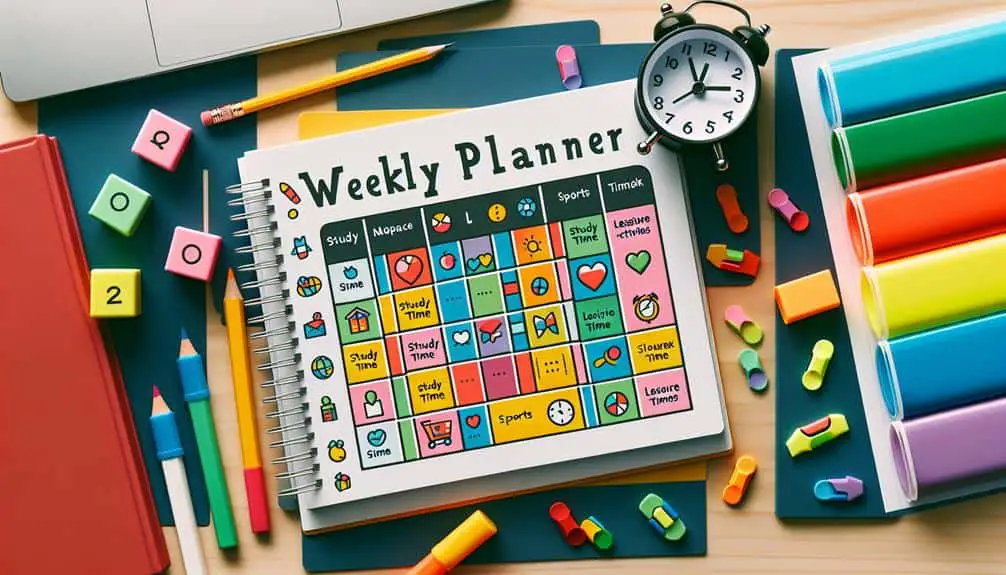To craft a Daily Homeschool Time Management Plan, start by setting clear goals to guide your day. Establish a structured routine with set wake-up times and meal schedules. Allocate time for different subjects to maintain balance and engagement. Remember to include breaks and physical activities for best results. Evaluate and adjust the plan regularly to enhance productivity. A strategic combination of these elements will guarantee effective learning and focus.
Key Points
- Set clear daily goals to prioritize tasks effectively.
- Establish a structured routine for consistency and focus.
- Allocate specific time slots for different subjects to maintain balance.
- Incorporate breaks and physical activities for optimal learning.
- Regularly evaluate and adjust the plan for improved time management.
Setting Clear Daily Goals
To effectively manage your time while homeschooling, begin by setting clear daily goals. Goal setting plays an important role in maintaining productivity and focus throughout your day.
Start by outlining what you aim to achieve each day, whether it's completing specific lessons, engaging in extracurricular activities, or setting aside time for self-study. When setting your goals, consider prioritizing tasks based on their significance and urgency. This will help you allocate your time efficiently and make sure that essential activities are completed first.
Establishing a Structured Routine
Creating a structured routine is crucial for maximizing productivity and maintaining a sense of order in your homeschooling day. Routine consistency is key to establishing a rhythm that helps you and your children stay focused and on track. Start by setting consistent wake-up times and meal schedules to create a framework for your day. Prioritizing tasks within your routine guarantees that essential subjects or activities are completed first when focus is at its peak. Consider incorporating breaks at regular intervals to prevent burnout and maintain motivation throughout the day.
To establish a structured routine, create a daily schedule that includes designated time slots for different subjects or activities. This will help you allocate enough time for each task while maintaining a balanced approach to learning. Be flexible with your routine, adjusting it as needed to accommodate unexpected events or changes in your family's schedule. By sticking to a structured routine with routine consistency, you can enhance productivity and create a more organized homeschooling environment for you and your children.
Planning Time for Different Subjects
Plan dedicated time slots for each subject in your homeschooling schedule to guarantee thorough coverage and effective learning. Subject rotation is a key strategy to maintain study balance and prevent monotony. By allotting specific time blocks for various subjects, you make sure that each area of study receives adequate attention. For example, you could schedule math in the morning when concentration levels are typically higher, followed by a creative subject like art or music to provide a rejuvenating break.
Consider the individual needs and interests of your child when planning the sequence of subjects. This tailored approach can enhance engagement and motivation. Rotating subjects not only prevents boredom but also allows for a more holistic educational experience. Additionally, it helps in developing diverse skills and prevents cognitive overload by spreading out challenging subjects throughout the day.
Incorporating Breaks and Physical Activity
Incorporate regular breaks and physical activity strategically into your homeschooling schedule to enhance productivity and overall well-being. It's crucial to balance learning with moments of rest and movement for best results.
Here are some effective ways to integrate breaks and physical activity into your homeschool routine:
- Outdoor Play: Schedule time for outdoor activities like a nature walk, backyard play, or a game of tag to refresh both the mind and body.
- Brain Breaks: Integrate short, fun activities between study sessions to help re-energize and refocus your child. This could include a quick dance party, a round of Simon Says, or a short yoga session.
- Stretching Exercises: Encourage your child to do simple stretching exercises to reduce stiffness and improve circulation, aiding in better concentration and alertness.
- Sports or Physical Games: Plan for structured physical activities like playing catch, shooting hoops, or even a mini obstacle course to keep your child active and engaged.
Evaluating and Adjusting the Plan
Consider evaluating the effectiveness of your homeschool time management strategy to identify areas for improvement and make necessary adjustments for better outcomes. Reflect on how well your current plan is working for you and your children. Are you able to accomplish the daily goals you have set? Are there any subjects or activities that consistently take longer than planned? By reflecting on these aspects, you can pinpoint areas that may need improvement.
Once you have identified areas that require adjustment, focus on improving your plan. This could involve reallocating time for certain subjects, modifying the schedule of breaks, or finding ways to enhance productivity during study sessions. Keep in mind that flexibility is key when making changes to your time management plan. What works one week may need tweaking the next, so stay open to refining your approach.
Regularly evaluating and adjusting your homeschool time management plan will help you optimize productivity and ensure a more successful learning experience for you and your children. Remember, the goal is to create a plan that works best for your unique homeschooling situation.




